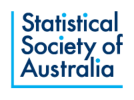Samantha Vilkns, Sujatha Raman and Will Grant contributed a short essay to The Conversation today on the trustworthiness of official statistics, that includes the rather pessimistic reason that statistics are trusted in so far as everyone else is using them.
It is over 10 years since the Australian government declared that what mattered in the policy world was evidence, by which was meant evidence based on figures reported by the national statistician or their proxy holders of the official statistics flame in other agencies.
It is almost thirty years since the government of the day demanded every proposal to cabinet be accompanied by a serious evaluative exercise, that meant then coming from a freshly minted statiustics dsection of the department equipped to design and management collections that can track the impact of policy positions.
It appears that little of this earnestness on intent has changed the way that puiblic statistics are managed or practitoners are trained: the article suggests that the numbers game in government has been commandeered by social scientists - analysts, swallowing whole what series are available before backtracking into deconstruction of the lmitations of particular numbers for the purpose - whether to promote, float or sink a proposal.
This 'anti-epistemology' approach: what we think we know is a fabrication of the circumstances of the evidence for its existence: has left those manning the engine room of official statistics without a voice.
The theory behind statistics - how we acquire knowledge of the world through quantitative probing - has languished overshadowed by our ability to digest enough volumes of data however acquired. Inference by weight of numbers results. such positvism, favouring activity over need or foresight or risk; has tempted government down the path of behavioural manipulation - 'business analytics' and away from a contrasting philosophy that I will dub ambiguously "the health of a full society".
Statistics can serve a far more open role in the latter, revealing strengths and vulnerabilities in citizens. Neither free agents, nor hapless consumers, citizens are the communicating heart of society.
A theory of statistics built around this model develops the idea of an information map for which inference is sought on engineering principles governing the efficient design of instruments that serve this purpose. All these processes are transparent in intent.
The result is an evolving superstructure that guides and reflects back the operation opf public programmes, subject to politcial process at a remove from the management of this frame.
https://theconversation.com/how-do-we-know-statistics-can-be-trusted-we-talked-to-the-humans-behind-the-numbers-to-find-out-148339?utm_medium=email&utm_campaign=Latest%20from%20The%20Conversation%20for%20October%2023%202020%20-%201766217118&utm_content=Latest%20from%20The%20Conversation%20for%20October%2023%202020%20-%201766217118+CID_650e2fe74e85a98458995c7f892bb0da&utm_source=campaign_monitor&utm_term=How%20do%20we%20know%20statistics%20can%20be%20trusted%20We%20talked%20to%20the%20humans%20behind%20the%20numbers%20to%20find%20out
